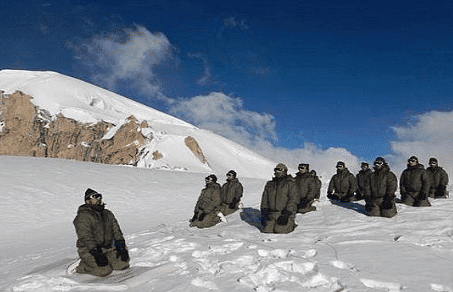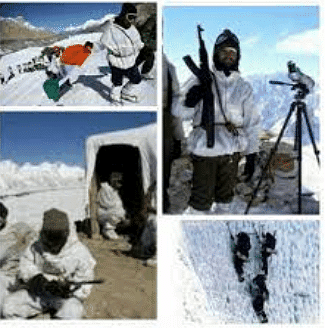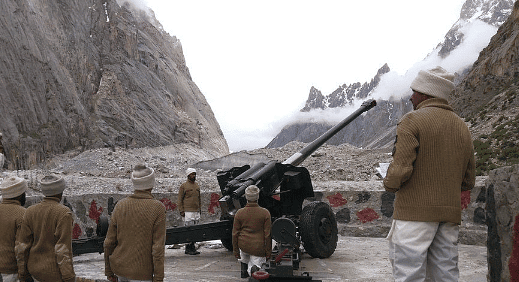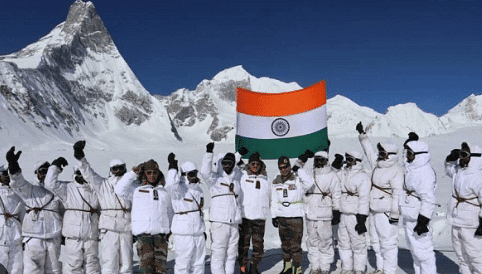CDS Exam > CDS Notes > Preparation Tips for SSB Interview > Sample Lecturette 3: Siachen Conflict
Sample Lecturette 3: Siachen Conflict | Preparation Tips for SSB Interview - CDS PDF Download
| Table of contents |

|
| About Siachen |

|
| Life at Siachen |

|
| The Bone of Contention |

|
| World’s Highest Battlefield |

|
| Facts about Siachen |

|
Siachen Dispute: Among the various border conflicts happening worldwide, the issue surrounding the highest battlefield in the world attracts special attention from nations. The origins of the Siachen dispute (known as the place of roses) can be found on the map beyond NJ9842 in the undefined area on the western side. Now, let's delve into the details of the Siachen War.
About Siachen
Siachen, the massive glacier situated on the eastern side of the Karakoram range in the Himalayas, holds significant importance as the largest source of fresh water on the Indian Subcontinent. It also serves as the origin of the Nubra river, which in turn is the primary source of the Indus river.
 Since 1984, the entire Siachen glacier has been under Indian administration and control, with Pakistani posts located more than 3000 feet below the Indian posts on Saltoro ridge. Stretching over approximately 80 kilometres in length and covering an area of 700 square kilometres, it is the second-largest glacier globally. The glacier descends from an altitude of around 5,700 feet above sea level.
Since 1984, the entire Siachen glacier has been under Indian administration and control, with Pakistani posts located more than 3000 feet below the Indian posts on Saltoro ridge. Stretching over approximately 80 kilometres in length and covering an area of 700 square kilometres, it is the second-largest glacier globally. The glacier descends from an altitude of around 5,700 feet above sea level.Life at Siachen
Life at Siachen poses immense challenges due to the extreme weather conditions. Soldiers on both sides are stationed at an elevation of around 23,000 feet above sea level, enduring temperatures that plummet as low as minus 55 degrees Celsius. The scarcity of oxygen exacerbates the situation, leading to major problems. Soldiers also suffer from hypothermia and frostbites, and obtaining fresh drinking water is a significant challenge. Surprisingly, the primary cause of fatalities among soldiers from both countries is not the conflict between them, but rather the harsh weather conditions.
 Life at Siachen poses immense challenges due to the extreme weather conditions. Soldiers on both sides are stationed at an elevation of around 23,000 feet above sea level, enduring temperatures that plummet as low as minus 55 degrees Celsius. The scarcity of oxygen exacerbates the situation, leading to major problems. Soldiers also suffer from hypothermia and frostbites, and obtaining fresh drinking water is a significant challenge. Surprisingly, the primary cause of fatalities among soldiers from both countries is not the conflict between them, but rather the harsh weather conditions.
Life at Siachen poses immense challenges due to the extreme weather conditions. Soldiers on both sides are stationed at an elevation of around 23,000 feet above sea level, enduring temperatures that plummet as low as minus 55 degrees Celsius. The scarcity of oxygen exacerbates the situation, leading to major problems. Soldiers also suffer from hypothermia and frostbites, and obtaining fresh drinking water is a significant challenge. Surprisingly, the primary cause of fatalities among soldiers from both countries is not the conflict between them, but rather the harsh weather conditions.The Bone of Contention
The core of the dispute surrounding Siachen lies in the fact that both India and Pakistan claim sovereignty over the Jammu and Kashmir region. Indian and Pakistani troops are positioned on the Line of Control (LoC) flanking the Siachen glacier. The root cause is the absence of a clearly defined ceasefire line on the map, resulting in several contentious issues. The Kashmir conflict and disputes over water distribution are the major points of contention revolving around Siachen. Furthermore, the 1949 Karachi agreement and the 1972 Shimla agreement presumed that human habitation in this area was unviable.
World’s Highest Battlefield
Being a crucial defence point for Ladakh and Leh, India argues that occupying the glacier is necessary. However, reaching an agreement on demilitarising the glacier has proven elusive for both parties. India maintains that the demarcation should extend north along the Saltoro ridge to the China border, while Pakistan insists on a northeasterly course up to the Karakoram Pass.
 Thus, a consensus has not been reached. India contends that Pakistan's actions amount to a cartographic invasion of the area. In the early 1980s, India's intelligence agency discovered Pakistan's acquisition of high-altitude military gear.Anticipating a conflict, India deployed two platoons of soldiers to critical passes on the Saltoro Ridge. Since then, soldiers from both countries have been stationed at different parts of the glacier, each vying to assert territorial ownership.
Thus, a consensus has not been reached. India contends that Pakistan's actions amount to a cartographic invasion of the area. In the early 1980s, India's intelligence agency discovered Pakistan's acquisition of high-altitude military gear.Anticipating a conflict, India deployed two platoons of soldiers to critical passes on the Saltoro Ridge. Since then, soldiers from both countries have been stationed at different parts of the glacier, each vying to assert territorial ownership.Operation Meghdoot
Operation Meghdoot, executed on 3rd April 1984 and led by Lieutenant General Prem Nath Hoon, marked India's first assault to recapture the Siachen Glacier. Notably, Pakistan had also ordered a substantial amount of arctic gear from the same European supplier who was selling equipment to India, indicating their preparations for high-altitude military operations. Pakistan airdropped troops into Siachen and initiated their operation on 13th April 1984, subsequently capturing the strategic location of Qaid Post by June 1987.
Operation Rajiv
After three years of clashes between India and Pakistan, India decided to reclaim the glacier in 1987. The Pakistani position at this peak provided them with clear visibility of Indian movements. Naib Subedar Bana Singh, along with his men, launched a surprise attack and successfully captured the Qaid post. He was later awarded the Param Vir Chakra for his brave actions.
Ceasefire Treaty of 2003
In 2003, India and Pakistan agreed to a ceasefire treaty aimed at reducing cross-border violence. This agreement came into effect due to escalating tensions and the loss of manpower on both sides, as diplomatic negotiations regarding the Siachen glacier had failed. Although the Actual Ground Position Line (AGPL) separates Indian and Pakistani positions, soldiers continue to lose their lives due to various factors.
 Many analysts advocate for the demilitarisation of Siachen, considering the significant loss of soldiers and military resources. However, the concern is that if India withdraws its troops from the area, Pakistan might perceive it as an opportunity to assert control over the disputed territory. A wise approach would involve reaching a diplomatic agreement accepted by both parties, followed by the complete withdrawal of troops from the region.Realistically, the chances of such an agreement occurring are minimal, given that Pakistan does not recognise any part of the glacier as belonging to India, and vice versa.
Many analysts advocate for the demilitarisation of Siachen, considering the significant loss of soldiers and military resources. However, the concern is that if India withdraws its troops from the area, Pakistan might perceive it as an opportunity to assert control over the disputed territory. A wise approach would involve reaching a diplomatic agreement accepted by both parties, followed by the complete withdrawal of troops from the region.Realistically, the chances of such an agreement occurring are minimal, given that Pakistan does not recognise any part of the glacier as belonging to India, and vice versa.Facts about Siachen
Additional facts about Siachen reveal the physical and health challenges faced by soldiers living at such high altitudes. Problems like weight loss, memory loss, and sleeping disorders are common among them.
 Tragically, a total of 869 soldiers and officers have succumbed to the hardships endured at the Siachen Glacier. Nonetheless, the soldiers find ways to keep themselves engaged and content in their surroundings.
Tragically, a total of 869 soldiers and officers have succumbed to the hardships endured at the Siachen Glacier. Nonetheless, the soldiers find ways to keep themselves engaged and content in their surroundings.
The document Sample Lecturette 3: Siachen Conflict | Preparation Tips for SSB Interview - CDS is a part of the CDS Course Preparation Tips for SSB Interview.
All you need of CDS at this link: CDS
|
99 videos|112 docs|65 tests
|
Related Searches














